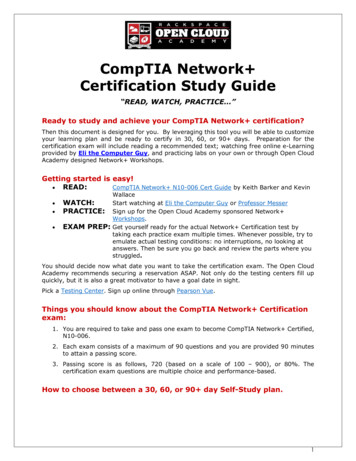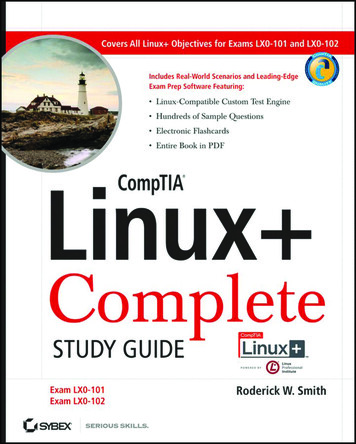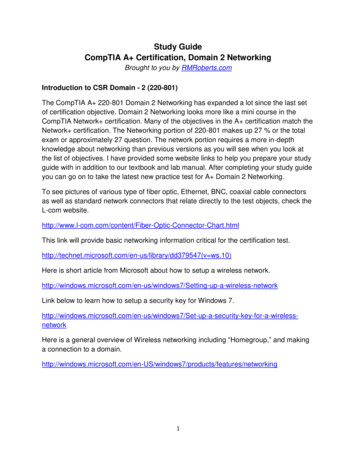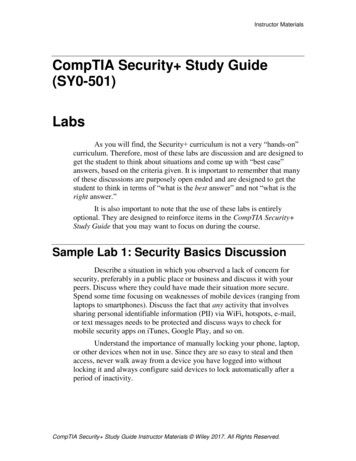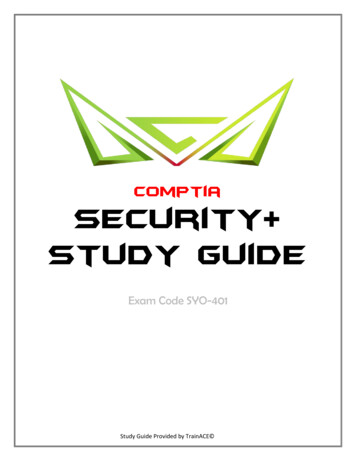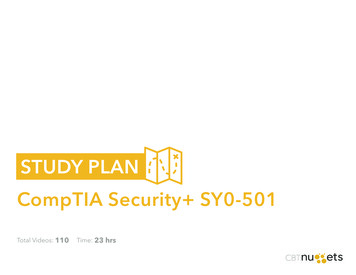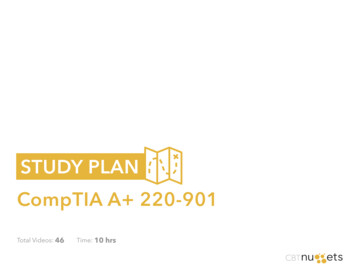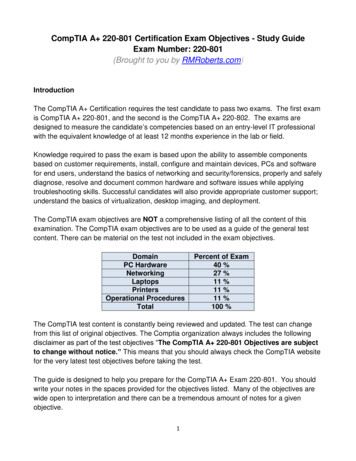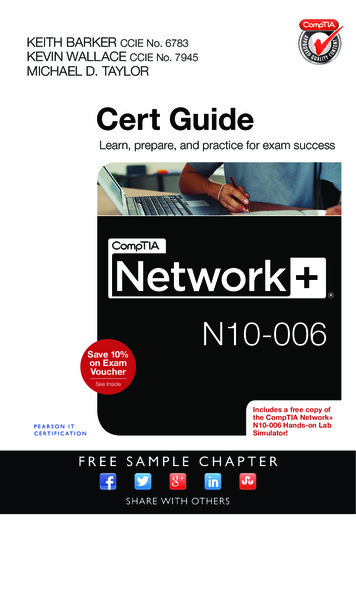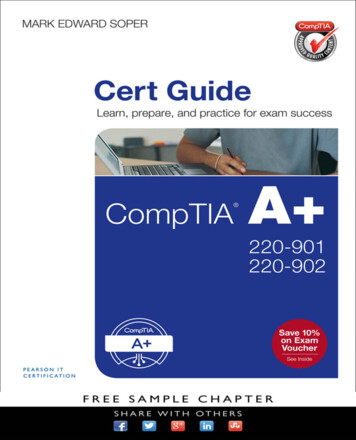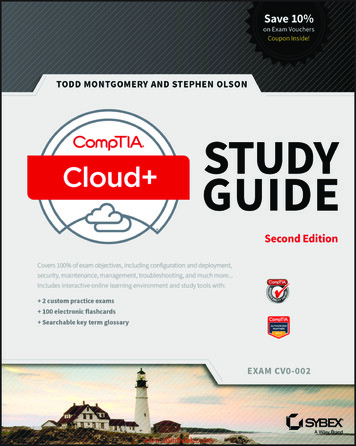
Transcription
www.allitebooks.com
www.allitebooks.com
www.allitebooks.com
www.allitebooks.com
CompTIA Cloud Study GuideSecond EditionExam CV0-002Todd MontgomeryStephen Olsonwww.allitebooks.com
Senior Acquisitions Editor: Kenyon BrownDevelopment Editor: David ClarkTechnical Editor: Kunal MittalProduction Manager: Kathleen WisorCopy Editor: Kim WimpsettEditorial Manager: Pete GaughanExecutive Editor: Jim MinatelBook Designer: Judy Fung and Bill GibsonProofreader: Nancy CarrascoIndexer: Johnna VanHoose DinseProject Coordinator, Cover: Brent SavageCover Designer: WileyCover Image: @Jeremy Woodhouse/Getty Images, Inc.Copyright 2018 by John Wiley & Sons, Inc., Indianapolis, IndianaPublished simultaneously in CanadaISBN: 978-1-119-44305-6ISBN: 978-1-119-44306-3 (ebk.)ISBN: 978-1-119-44296-7 (ebk.)Manufactured in the United States of AmericaNo part of this publication may be reproduced, stored in a retrieval system or transmitted in any form orby any means, electronic, mechanical, photocopying, recording, scanning or otherwise, except as permitted under Sections 107 or 108 of the 1976 United States Copyright Act, without either the prior writtenpermission of the Publisher, or authorization through payment of the appropriate per-copy fee to theCopyright Clearance Center, 222 Rosewood Drive, Danvers, MA 01923, (978) 750-8400, fax (978)646-8600. Requests to the Publisher for permission should be addressed to the Permissions Department,John Wiley & Sons, Inc., 111 River Street, Hoboken, NJ 07030, (201) 748-6011, fax (201) 748-6008, oronline at http://www.wiley.com/go/permissions.Limit of Liability/Disclaimer of Warranty: The publisher and the author make no representations or warranties with respect to the accuracy or completeness of the contents of this work and specifically disclaimall warranties, including without limitation warranties of fitness for a particular purpose. No warrantymay be created or extended by sales or promotional materials. The advice and strategies contained hereinmay not be suitable for every situation. This work is sold with the understanding that the publisher is notengaged in rendering legal, accounting, or other professional services. If professional assistance is required,the services of a competent professional person should be sought. Neither the publisher nor the authorshall be liable for damages arising herefrom. The fact that an organization or Web site is referred to in thiswork as a citation and/or a potential source of further information does not mean that the author or thepublisher endorses the information the organization or Web site may provide or recommendations it maymake. Further, readers should be aware that Internet Web sites listed in this work may have changed ordisappeared between when this work was written and when it is read.For general information on our other products and services or to obtain technical support, please contactour Customer Care Department within the U.S. at (877) 762-2974, outside the U.S. at (317) 572-3993 orfax (317) 572-4002.Wiley publishes in a variety of print and electronic formats and by print-on-demand. Some materialincluded with standard print versions of this book may not be included in e-books or in print-on-demand.If this book refers to media such as a CD or DVD that is not included in the version you purchased, youmay download this material at http://booksupport.wiley.com. For more information about Wileyproducts, visit www.wiley.com.Library of Congress Control Number: 2018933560TRADEMARKS: Wiley, the Wiley logo, and the Sybex logo are trademarks or registered trademarks ofJohn Wiley & Sons, Inc. and/or its affiliates, in the United States and other countries, and may not be usedwithout written permission. CompTIA and Cloud are registered trademarks of CompTIA Properties, LLC.All other trademarks are the property of their respective owners. John Wiley & Sons, Inc. is not associatedwith any product or vendor mentioned in this book.10 9 8 7 6 5 4 3 2 1
To my awesome son, William, and incredible daughter, Allison: This book isdedicated to both of you.—Todd MontgomeryTo my amazing wife, Melissa, and children, Cole and Kate: I am humbledby your patience and love as I write and work long hours. Thank you forkeeping me grounded.—Stephen Olson
About the AuthorsTodd Montgomery has been in the networking industry for more than 35 years and holdsmany certifications from CompTIA, Cisco, Juniper, VMware, and other companies. He isCompTIA Cloud , Network , and Security certified.Todd has spent most of his career out in the field working on-site in data centersthroughout North America and around the world. He has worked for equipment manufacturers, systems integrators, and end users of data center equipment in the public, serviceprovider, and government sectors. He is currently working as a writer and technical editorand is involved in cloud projects.Todd lives in Austin, Texas, and in his free time enjoys auto racing, general aviation, andAustin’s live music venues. He can be reached at toddmont@thegateway.net.Stephen Olson has been in the networking industry for almost 15 years and holds manycertifications including Cisco’s CCIE #21910, the Cisco CCNA, and CCNP, among others.Steve has spent the majority of his career working in large enterprises as well as consultingfor service providers around the world in the cloud, WAN, and data center segments. Heis currently working on SDN projects in the WAN and data center spaces as well as cloudnetworking. He resides in Austin, Texas, and enjoys music and guitar in his free time. Stevecan be reached at stephenjolson@gmail.com.
AcknowledgmentsThere are many people who work to put a book together, and although as authors we dedicate an enormous amount of time to writing the book, it would never be published withoutthe dedicated, hard work of the whole team at Wiley. They are truly a fantastic group towork with, and without the Wiley team this book would have never been possible.First, we’d like to thank Kenyon Brown, our senior acquisitions editor, who offered ussupport and guidance through the writing process. Ken was always there to answer questions and point us in the right direction. Without Ken as a mentor, we could never havepulled this one off.We also can never thank our development editor, David Clark, too many times; David isa true professional who stayed on top of the schedule and professionally reminded us of thenext upcoming deadline we were working to meet. Without David’s help, putting this booktogether would have been much more difficult. David has the ability to take the raw textfrom the authors, who are primarily engineers, and manage to turn it into presentable copy.Thanks again, David!Kunal Mittal offered excellent input as our technical editor. He gave us invaluablefeedback on how to make the technical concepts more understandable to the readers andpointed out where we needed to modify our technical content for accuracy. It was greatthat Kunal was able to be on this project with us.A big thank you to Katie Wisor, the production editor on this project. Kim Wimpsettworked the markup magic in the background as the copyeditor. The authors are bothamazed at how Katie and Kim along with their team of professionals could take our workand transform it into such a presentable book. We’re sure there is a whole staff at Wileylurking in the background, and we will never know how much they helped, but to everyoneat Wiley, a big thank-you! You made the late nights and long weekends of writing and putting this book together all worthwhile.
ContentsIntroductionxviiCloud Assessment TestChapter1An Introduction to Cloud ComputingConfigurations and DeploymentsIntroducing Cloud ComputingCloud Service ModelsCloud Reference Designs and Delivery ModelsIntroducing Cloud ComponentsConnecting the Cloud to the Outside WorldInitial DocumentationSelecting Cloud Compute ResourcesValidating and Preparing for the Move to the CloudWhat Is the Architecture?Choosing Elements and Objects in the CloudCreating and Validating a Cloud DeploymentThe Cloud Shared Resource Pooling ModelOrganizational Uses of the CloudScaling and Architecting Cloud SystemsBased on RequirementsUnderstanding Cloud PerformanceDelivering High Availability OperationsConnecting Your Organization to the RemoteCloud Data CenterWhat Are the Tools Used for Remote Management?Cloud TestingVerifying System RequirementsCorrect Scaling for Your RequirementsMaking Sure the Cloud Is Always AvailableUnderstanding Direct and Virtual Cloud ConnectionsKeeping Your Data Safe (A Word About Data Integrity)Making Sure Your Cloud Deployment IsFunctioning as ExpectedWriting It All Down (Documentation)Creating a Known Reference Point (Baselines)What Is the Responsibility of the CloudService Provider?Variations in the Cloud: Performance MetricsSummaryExam EssentialsWritten LabReview 26272832323333333434353738
xContentsChapter2Cloud Deployments43Executing a Cloud DeploymentUnderstanding Deployment and Change ManagementCloud Deployment ModelsNetwork Deployment ConsiderationsComparing BenchmarksMatching Physical Resources to the Virtualized World ofthe CloudWhat Are Available and Proposed Hardware Resources?Physical Resource High AvailabilityIntroducing Disaster RecoveryPhysical Hardware Performance BenchmarksCosts Savings When Using the CloudEnergy Savings in the CloudShared vs. Dedicated Hardware Resourcesin a Cloud Data CenterConfiguring and Deploying StorageIdentifying Storage ConfigurationsStorage ProvisioningStorage Priorities: Understanding Storage TiersManaging and Protecting Your Stored DataStorage Security ConsiderationsAccessing Your Storage in the CloudManaging Cloud StoragePerforming a Server MigrationDifferent Types of Server MigrationsUnderstanding the Virtualization FormatsNeeded When MigratingAddressing Application PortabilityWorkload Migration Common ProceduresExamining Infrastructure Capable of Supportinga MigrationManaging User Identities and RolesRBAC: Identifying Users and What Their Roles AreIdentity Applications in the Public CloudWhat Happens When You Authenticate?Giving Authorization to Access Specific Cloud ServicesUnderstanding FederationsSingle Sign-on SystemsUnderstanding Infrastructure ServicesSummaryExam EssentialsWritten LabReview 2828385868686888889898989909093949597
ContentsChapterChapterChapter345xiSecurity in the Cloud101Cloud Security Compliance and ConfigurationsEstablishing Your Company’s Security PoliciesSelecting and Applying the Security Policiesto Your Cloud OperationsSome Common Regulatory RequirementsEncrypting Your DataSecurity Certificates and KeysRemote Access SecurityAutomating Cloud SecuritySecurity Templates for Compute PlatformsAccess ControlAccessing Cloud-Based ObjectsCloud Service Models and SecurityCloud Deployment Models and SecurityApplying Access ControlsSummaryExam EssentialsWritten LabReview 0122123124125Implementing Cloud Security129Implementing Security in the CloudData ClassificationSegmenting Your DeploymentImplementing EncryptionApplying Multifactor AuthenticationRegulatory and Compliance Issues During ImplementationAutomating Cloud SecurityAutomation ToolsTechniques for Implementing Cloud SecuritySecurity ServicesSummaryExam EssentialsWritten LabReview 8Maintaining Cloud OperationsApplying Security PatchesCloud Element SecurityPatching MethodologiesPatching Order of Operations and Dependencies153155155157161
xiiChapterChapterContents67Updating Cloud ElementsUnderstanding the Different Types of UpdatesWorkflow AutomationVirtualization Automation Tools and ActivitiesStorage OperationsTypes of BackupsBackup TargetsBackup and Restore OperationsSummaryExam EssentialsWritten LabReview ter Recovery, Business Continuity,and Ongoing Maintenance181Implementing a Disaster Recoveryand Business Continuity PlanService Provider Responsibilities and CapabilitiesDisaster Recovery Models and TechniquesBusiness ContinuityEstablishing a Business Continuity PlanEstablishing Service Level AgreementsCloud MaintenanceEstablishing Maintenance WindowsMaintenance Interruptions to OperationsMaintenance Automation Impact and ScopeCommon Maintenance Automation TasksSummaryExam EssentialsWritten LabReview 3205Cloud Management211Introduction to Cloud ManagementCloud MetricsMonitoring Your DeploymentCloud Support AgreementsStandard Cloud Maintenance ResponsibilitiesConfiguration Management Applications and ToolsChange Management ProcessesAdding and Removing Cloud ResourcesDetermining Usage PatternsBurstingMigrating Between Cloud Providers214215216221222222222224224224224
ContentsScaling Resources to Meet RequirementsExtending the Scope of the CloudUnderstanding Application Life CyclesCorporate ChangesManaging Account ProvisioningAccount IdentificationAuthenticationAuthorizationManaging the Account Life CycleAccount Automation and OrchestrationSummaryExam EssentialsWritten LabReview QuestionsChapter8Cloud Management Baselines, Performance,and SLAsMeasuring Your DeploymentAgainst the BaselineObject Tracking for Baseline ValidationApplying Changes to the Cloud to MeetBaseline RequirementsChanging Operations to Meet ExpectedPerformance/Capacity RequirementsCloud Accounting, Chargeback, and ReportingSummaryExam EssentialsWritten LabReview QuestionsChapter9TroubleshootingExamining Common Cloud IssuesAutomationCloud InteroperabilityInterconnectionsLanguage SupportLicensingNetworkingResource Contention and StarvationService OutagesTemplatesTime 65267267268269269269270271271272272272
xivContentsTroubleshooting Cloud Capacity IssuesCapacity Boundaries in the CloudExceeding Your Baseline MeasurementsExpecting the Unexpected, Unplanned ExpansionsTroubleshooting Automationand OrchestrationProcess and Workflow IssuesSummaryExam EssentialsWritten LabReview QuestionsChapter10Troubleshooting Networking and SecurityIssues and Understanding MethodologiesTroubleshooting Cloud Networking IssuesIdentifying the Common Networking Issues inthe CloudNetwork Troubleshooting and Connectivity ToolsRemote Access ToolsTroubleshooting Security IssuesAccount Privilege EscalationSign-On tificate Configuration IssuesDevice-Hardening SettingsExternal AttacksIdentifying Weak or Obsolete Security TechnologiesInternal AttacksMaintain Sufficient Security Controls and ProcessesNetwork Access Tunneling and EncryptionPhysical Access, Infrastructure, and AvailabilityUnencrypted Communications and DataTroubleshooting MethodologyCorporate Policies, Procedures, and the Impactof Implementing ChangesSteps to Identify the ProblemSummaryExam EssentialsWritten LabReview 15317318320320322323
ContentsAppendixAAnswers to Review QuestionsChapter 1: An Introduction to Cloud ComputingConfigurations and DeploymentsChapter 2: Cloud DeploymentsChapter 3: Security in the CloudChapter 4: Implementing Cloud SecurityChapter 5: Maintaining Cloud OperationsChapter 6: Disaster Recovery, Business Continuity, andOngoing MaintenanceChapter 7: Cloud ManagementChapter 8: Cloud Management Baselines, Performance,and SLAsChapter 9: TroubleshootingChapter 10: Troubleshooting Networking and SecurityIssues and Understanding MethodologiesAppendixBAnswers to Written LabsChapter 1: An Introduction to Cloud ComputingConfigurations and DeploymentsChapter 2: Cloud DeploymentsChapter 3: Security in the CloudChapter 4: Implementing Cloud SecurityChapter 5: Maintaining Cloud OperationsChapter 6: Disaster Recovery, Business Continuity,and Ongoing MaintenanceChapter 7: Cloud ManagementChapter 8: Cloud Management Baselines, Performance,and SLAsChapter 9: TroubleshootingChapter 10: Troubleshooting Networking and SecurityIssues and Understanding 342345346346346347347348348349349350351
Becoming aCompTIA CertifiedIT Professional is EasyIt’s also the best way to reach greaterprofessional opportunities and rewards.Why Get CompTIA Certified?Growing DemandHigher SalariesLabor estimates predictsome technology fields willexperience growth of over 20%by the year 2020.* CompTIAcertification qualifies the skillsrequired to join this workforce.IT professionals withcertifications on their resumecommand better jobs, earnhigher salaries and have moredoors open to new multiindustry opportunities.LearnCompTIA certifications arevendor neutral—which meansthat certified professionalscan proficiently work withan extensive variety ofhardware and software foundin most organizations.CertifyLearn more about whatthe exam covers byreviewing the following:Purchase a voucher at aPearson VUE testing centeror at CompTIAstore.com. Exam objectives forkey study points. Register for your exam at aPearson VUE testing center: Sample questions for a generaloverview of what to expecton the exam and examplesof question format. Visit pearsonvue.com/CompTIA tofind the closest testing center to you. Visit online forums, like LinkedIn,to see what other IT professionalssay about CompTIA exams.Universal SkillsStrengths91% of hiring managersindicate CompTIA certificationsare valuable in validating ITexpertise, making certificationthe best way to demonstrateyour competency andknowledge to employers.**WorkCongratulations on yourCompTIA Make sure to add yourcertification to your resume. Check out the CompTIACertification Roadmap to planyour next career move. Schedule the exam online. You willbe required to enter your vouchernumber or provide paymentinformation at registration. Take your certification d* Source: CompTIA 9th Annual Information Security Trends study: 500 U.S. IT and Business Executives Responsible for Security** Source: CompTIA Employer Perceptions of IT Training and Certification 2015 CompTIA Properties, LLC, used under license by CompTIA Certifications, LLC. All rights reserved. All certification programs and education related to suchprograms are operated exclusively by CompTIA Certifications, LLC. CompTIA is a registered trademark of CompTIA Properties, LLC in the U.S. and internationally.Other brands and company names mentioned herein may be trademarks or service marks of CompTIA Properties, LLC or of their respective owners. Reproductionor dissemination prohibited without written consent of CompTIA Properties, LLC. Printed in the U.S. 02190-Nov2015
IntroductionWelcome to the exciting world of cloud computing and CompTIA certifications! If youpicked up this book because you want to improve yourself with a secure and rewardingjob in the new and fast-growing cloud computing space, you have come to the right place.Whether you are striving to enter the thriving, dynamic IT sector or seeking to enhanceyour skills in the emerging cloud computing field, being CompTIA Cloud certified canseriously stack the odds of success in your favor.CompTIA certifications are powerful instruments of success that will most certainlyimprove your knowledge of cloud computing. As you progress through this book, you’llgain a broad and deep understanding of cloud computing operations that offers unprecedented exposure to this dynamic field. The knowledge and expertise you will gain areessential for your success in all areas of the cloud computing field.By deciding to become Cloud certified, you’re proudly announcing to the world thatyou want to become an unrivaled cloud computing expert, a goal that this book with getyou well on your way to achieving. Congratulations in advance on the beginning of yourbrilliant future!For up-to-the-minute updates covering additions or modifications to theCompTIA certification exams, as well as additional study tools, videos,practice questions, and bonus material, be sure to visit the Sybex websiteand forum at www.sybex.com.Why Should You Become Certified in CloudTechnologies?CompTIA has created the world’s leading vendor-neutral family of certifications in thetechnology industry. CompTIA’s certifications are recognized and respected worldwide fortheir quality and rigorous standards. They offer a broad range of certifications on a widevariety of technology topics. When you become Cloud certified, you have validated yourskills and expertise in the implementation and ongoing support of cloud-based services.Becoming a CompTIA Cloud certified professional validates that you have the knowledgeto be a successful cloud engineer.The Cloud certification is recognized as one of the premier cloud certifications in themarket today. Studying for and passing the Cloud exam gives engineers a set of skills tosucceed in the fast-growing field of cloud computing.Rest assured that when you pass the CompTIA Cloud exam, you’re headed down apath to certain success!
xviiiIntroductionWhat Does This Book Cover?This book follows the most recent version of the CompTIA Cloud exam, CV0-002.The exam blueprint is divided into five sections consisting of ten chapters that cover allthe major topic areas. Each section is explained in sufficient detail to help you become aCloud certified professional.Chapter 1: An Introduction to Cloud Computing Configurations and Deployments Thebook starts out investigating the most common cloud components such as applications,compute, storage, and networking. Then how to determine the correct size and scale ofthe systems is discussed. You will get a basic understanding of configurations found in thecloud and learn about production, quality assurance, and development cloud systems.Chapter 2: Cloud Deployments In this chapter you’ll learn about deploying services in thecloud and how to execute a deployment plan; the most common service models; and thevarious ways that clouds are delivered such as public, private, and community. Commoncloud terminology and storage are explained.Next, the technical background is presented on how to determine the needs and design aneffective cloud deployment. This includes what virtualization is, its benefits, and why it isa central technology in cloud computing. You’ll learn about hypervisors, virtual machines,and how to migrate from your existing operations to the cloud.Chapter 3: Security in the Cloud Chapter 3 covers cloud security starting with securitypolices, laws and standards. You will then learn about specific security technologies, applications, and services.Chapter 4: Implementing Cloud Security Chapter 4 builds on your security knowledgeby explaining how to implement secure storage, networks, and compute systems. Securitytools, intrusion systems, encryption, tools, techniques, and services are introduced.Chapter 5: Maintaining Cloud Operations This chapter focuses on keeping your clouddeployment current with the latest updates and discusses the processes to follow. Automationis introduced, and you will learn about the importance of cloud automation and orchestrationsystems. The chapter concludes with a discussion on backing up your data in the cloud.Chapter 6: Disaster Recovery, Business Continuity, and Ongoing Maintenance We’ll takea step back in this chapter and cover how to go about developing a disaster recovery planand the common models available. You will learn the importance of business survivabilityduring a severe outage and understand the issues concerning recovery. The chapter endswith describing how to perform ongoing maintenance in your cloud environment.Chapter 7: Cloud Management You’ll now delve deep into the operations aspects of cloudcomputing. Chapter 7 begins with a discussion of monitoring the cloud and then moveson to look at the allocation and provisioning of resources. Then you will learn about business requirements, application life cycles, and the impact they have on managing your clouddeployment. The chapter concludes with discussion on security of your cloud operationswith accounts, automation, authentication and automation models.
IntroductionxixChapter 8: Cloud Management Baselines, Performance, and SLAs Chapter 8 explainshow to determine what is considered normal cloud operations by creating and maintainingbaseline measurements. Based on these measurements, we go on to discuss how to monitor your cloud fleet for deviations from the baseline and the steps to take when this occurs.Service level agreements and chargeback models are also explained in this chapter.Chapter 9: Troubleshooting Chapter 9 goes deep into the technical aspects identifying andcorrect cloud technical issues. We cover troubleshooting of new and existing deployments.You will learn about common problems found in the cloud that you will need to resolve. Wewill teach you how to identify and resolve deviations from your baselines and what to dowhen breakdowns in the workflow occur. Be sure to pay close attention to this chapter!Chapter 10: Troubleshooting Networking and Security Issues and UnderstandingMethodologies The final chapter continues investigating troubleshooting with a focus ontools and techniques. We will present common troubleshooting utilities found in Linux andWindows systems and how to perform a structured troubleshooting approach.Appendix A: Answers to Review Questionsbook’s review questions.Appendix B: Answers to Written Labswritten labs.This appendix contains the answers to theThis appendix contains the answers to the book’sInteractive Online Learning Environmentand Test BankWe’ve put together some great online tools to help you pass the Cloud exam. The interactive online learning environment that accompanies the Cloud exam certification guideprovides a test bank and study tools to help you prepare for the exam. By using these tools,you can dramatically increase your chances of passing the exam on your first try.Sample Tests Many sample tests are provided throughout this book and online, including the assessment test at the end of this Introduction and the review questions at the end ofeach chapter. In addition, there are two exclusive online practice exams with 50 questionseach. Use these questions to test your knowledge of the study guide material. The onlinetest bank runs on multiple devices.Flashcards The online text banks include 100 flashcards specifically written to hit youhard, so don’t get discouraged if you don’t ace your way through them at first! They’re thereto ensure that you’re ready for the exam. Armed with the review questions, practice exams,and flashcards, you’ll be more than prepared when exam day comes. Questions are providedin digital flashcard format (a question followed by a single correct answer). You can use theflashcards to reinforce your learning and provide last-minute test prep before the exam.Other Study Tools A glossary of key terms from this book and their definitions is available as a fully searchable PDF.
xxIntroductionGo to http://www.wiley.com/go/sybextestprep to register and gainaccess to this interactive online learning environment and test bank withstudy tools.How to Use This BookIf you want a solid foundation for the serious effort of preparing for the CompTIA CV0002 Cloud exam, then look no further. We’ve spent hundreds of hours putting togetherthis book with the sole intention of helping you to pass the exam as well as learn about theexciting field of cloud computing! The book is completely updated and refreshed from theoriginal to match the new version of the CompTIA Cloud exam, CV0-002.This book is loaded with valuable information, and you will get the most out of yourstudy time if you understand why the book is organized the way it is.To maximize your benefit from this book, we recommend the following study method:1.Take the assessment test that’s provided at the end of this Introduction. (The answersare at the end of the test.) It’s OK if you don’t know any of the answers; that’s why youbought this book! Carefully read over the explanations for any question you get wrongand note the chapters in which the material relevant to them is covered. This information should help you plan your study strategy.2.Study each chapter carefully, making sure you fully understand the information andthe test objectives listed at the beginning of each one. Pay extra-close attention to anychapter that includes material covered in questions you missed.3.Complete all written exams in each chapter, referring to the text of the chapter so thatyou understand the reason for each answer.4.Answer all the review questions related to each chapter. Many of the questions arepresented in a scenario format to emulate real-world tasks that you may encounter. (Theanswers appear in Appendix A.) Note the questions that confuse you, and study the topics they cover again until the concepts are crystal clear. Again, do not just skim thesequestions! Make sure you fully comprehend the reason for each correct answer. Remember that these will not be the exact questions you will find on the exam, but they’rewritten to help you understand the chapter material and ultimately pass the exam.5.Each chapter also concludes with a fill-in-the-blank type of written exam that is designedto improve your memory and comprehension of key items that were presented in thechapter. These are great for test preparation. We suggest going over these questions untilyou are able to consistently answer them error free. (The answers appear in Appendix B.)6.Try your hand at the practice questions that are exclusive to this book. The questionscan be found at http://www.wiley.com/go/sybextestprep.7.Test yourself using all the flashcards, which are also found at http://www.wiley.com/go/sybextestpr
About the Authors Todd Montgomery has been in the networking industry for more than 35 years and holds many certifications from CompTIA, Cisco, Juniper, VMware, and other companies. He is Co

